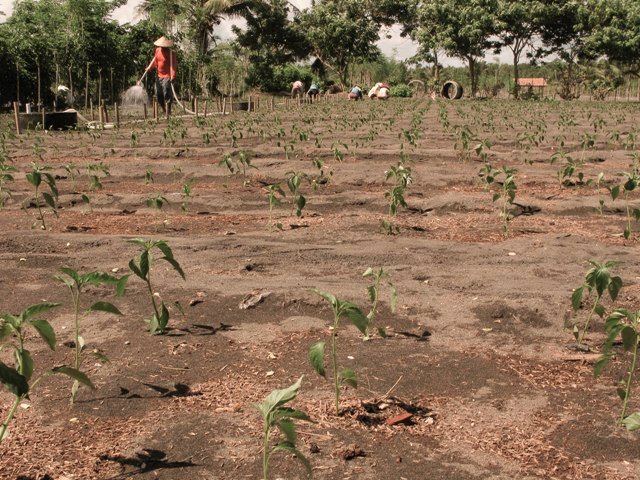-
About
- Our Work
- Get Involved
- Stay Updated
Our guest author, Nadya Karimasari, a researcher at Land Research Action Network opens our brand new blogging series that shines a spotlight on young people’s views and recommendations on sustainable agricultural development. This series is part of an ongoing partnership between Farming First and Young Professionals for Agricultural Development.
Discussions on the role of youth in agriculture tend to be oversimplified into agriculture being unattractive.
This is problematic for three reasons. First, it lumps youth together, as if they were all coming from similar contexts, overlooking the youth that are apparently attracted or already engaged in agriculture. Second, it does not sufficiently define what “farming” or “being involved in agriculture” entails, as the problem might not be the agricultural sector itself, but the types of involvement are available for youth. Third, it assumes youth will opt out for a lifetime, dismissing the flexible and multiple ways youth could be engaged.
A different set of questions could tell a completely different story. In Indonesia, for example, concerns over the ongoing trends of youth leaving agriculture have been challenged by an apparent increase in reversed youth migration from urban to rural areas. What is luring these young people away from the cities, and back to farms?
Upward social mobility
Research conducted by AKATIGA (2014) found that the possibility for upward social mobility is crucial to entice youth into agriculture. They are not simply attracted or not attracted to the sector, it depends on the social context they come from and what kind of involvement they are being offered. Is it farm-labour? Semi-labour with other sources of income? Or would they be the owner of farm?
One young person interviewed by AKATIGA commented: “If you asked young farmers who have or would inherit land, of course agriculture is a bright prospect for them. But there is no future in agriculture for young people like me who have no land nor inheritance.”
Marginal land, arable land, and independence
In the sandy coastal area of Kulon Progo, Yogyakarta, youth are increasingly coming back to agriculture. The main reason has been the overwhelmingly high yields of chilli and watermelon and the subsequent high farmer income, in contrast to the precariousness of the labour market in urban areas.
The marginality of land enabled landless people, including youth, to get their own plots, fulfilling the desire for upward social mobility as mentioned above. From labouring for someone else, or worse still in precarious employment in the city, they are becoming self-employed and have more control over their livelihood.
This feeling of independence is also enhanced by the inputs and technologies used on the farm, with these young farmers preferring simple, self-made technologies, seed-sharing mechanisms and organic fertilizers.
 Photo credit: Paguyuban Petani Lahan Pantai, Kulon Progo
Photo credit: Paguyuban Petani Lahan Pantai, Kulon ProgoStrong organization, good control of market
Good production alone is not sufficient, as it could be overshadowed by failure in the market. To conquer the market, through their own local grassroots organization, these farmers manage the timing and period of planting in order to gain sustainable harvest throughout the year. This way, the tendency to overproduce during high season that makes price very low can be avoided.
They also keep the price high through farmers auction. Conventional ways of selling through “tengkulak” or middle men was proven to result in very low price for their produce, favouring the profit for the middleman. Instead, these farmers organize auction events, where the buyers must put their bid inside an envelope, and those who offer the highest price could buy the produce. These farmer organizations allow the farmers to “raise each other up” by getting the best price guaranteed for their produce.
Organization is key for farmers to gain more control over their livelihood. Its networks can provide information on potential land for farming and assist farm set-up. It also supplies better peer-to-peer information on what crops most suitable to be planted, where to get inputs, what type of supporting technology is most appropriate and affordable, and howto make the best out of their activities.
If the rest of the world can follow Indonesia’s example, perhaps many more youth would see farming as a viable career. By promising upward social mobility, high yields on good land and strong access to market through effective organisations, perhaps farming would not be seen as such an “ugly” profession after all.
Read more by Nadya at http://nadya.wordpress.com
About the author
Author's recent posts
More posts from authorRelated Posts
Comments
No comments made yet. Be the first to submit a commentBy accepting you will be accessing a service provided by a third-party external to https://www.ypard.net/
Get in touch
Email: [email protected]
YPARD Global Coordination UnitHosted by AGRIDEA and the Czech University of Life Sciences Prague
Lausanne, Switzerland and Prague, Czech Republic - Our Work

 Photo credit: Paguyuban Petani Lahan Pantai, Kulon Progo
Photo credit: Paguyuban Petani Lahan Pantai, Kulon Progo